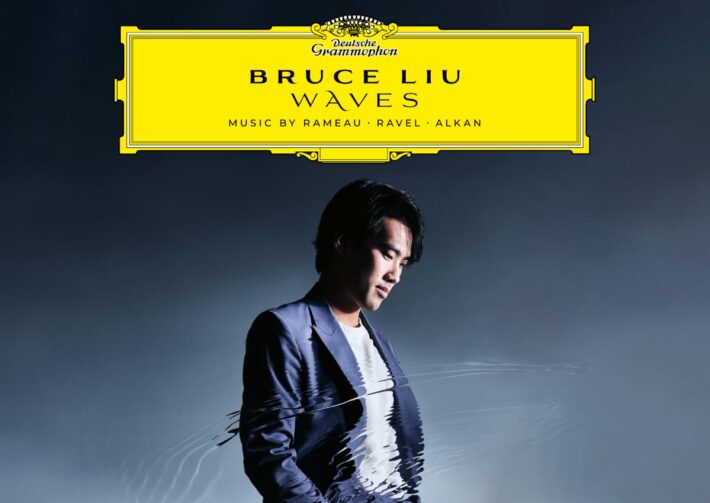Last year, I reviewed Bruce Liu’s debut release for DG, a compilation of performances from 18th Chopin competition, where I found remarkable his ability to balance finesse with spontaneity. I was curious to see whether he could achieve the same in the diversified curation of his sophomore album. With its intriguing juxtaposition of Rameau, Ravel, and Alkan, we see a pianist willing to explore and experiment with programming.
Liu’s beautiful sound quality comes out right away in Rameau’s Gavotte and Six Doubles (tracks 1-7). The theme is expressive but contemplative; good voice leading and nice switch-ups in articulation across repeats make Var. 1 come to life. And in Var. 3, the fingerwork is flawless: despite the intricate weaving of theme and secondary textures, Liu never loses melodic continuity or his lovely color palette of dynamics. The pianist explains in the liner notes that Rameau’s sound is distinctly dry, direct, and bouncy—these characters are front and center in Var. 4, but I’d have liked a touch more dryness and space between the staccatos. Another thing that could be better is the tempo management: although it’s clear that he aims to eschew a wooden, metronomic feel, some of the stop-and-starts feel overdone. The minor transgressions are certainly forgotten by the time we get to the final variation: its perpetuum mobile accompaniment is bold and exciting but tasteful.
Where Rameau’s elegance is restrained (perhaps by the Baroque idiom itself), Ravel’s is kaleidoscopic as we hear in the the six unique vignettes of his Miroirs. One of Liu’s best is Oiseaux Tristes (track 11). The ‘sadness’ suggested by the title doesn’t quite prepare us for a decidedly more sinister angle. Liu takes it one step further with an even more macabre spin that reminds me of Le Gibet from Gaspard de la Nuit. By really sitting on the dissonances, their full eeriness comes through; and don’t forget about the sharp, surging rush of notes in the middle—a terrifying portrayal of the rustle of feathers. In Un barque sur l’Océan (track 12), Liu opts for waves on the bolder (but not too choppy) side in a more dramatic interpretation of the piece. Although a matter of personal taste, I do prefer other interpretations: Jean-Efflam Bavouzet’s is lighter and less stormy but still elegantly imaginative. Louie Lortie’s sits right in the middle: the softer parts are shimmery and silky but the surges carry an exhilarating zing. As for La Vallée des Cloches (track 14), it is very much a study in subtlety, but this plays to Liu’s strengths. By again allowing the harmonies to fully peak and naturally dissipate, we are left to dwell in a panoramic and atmospheric soundscape.
Related Classical Music Reviews
- Review: Beatrice Rana Plays Ravel and Stravinsky
- Review: “Versailles” – Alexandre Tharaud, Piano
- Review: “33” – Simon Ghraichy, Piano (DG)
The Alkan Etudes (track 15-21), offer a nice tie-in to the Rameau (they too are in the form of a theme and variations) but are also the perfect complement to the other quieter works. What I liked especially was how Liu infuses a certain amount of stubbornness into the robust character but then also adds touches of playful humor in subsequent moments. And of course, as etudes imply, we do get our fill of excitement in hearing Liu’s technical facility.
The choice to include the Barcarolle from Recuil de chants (track 8) not only keeps the water theme intact but also speaks to Alkan’s diversity: unlike the variations, this small gem emerges from a foggy distance, coming forward at times but always somehow pulling back just when we seem to grasp it.
Liu ends with Rameau’s beloved La Poule. While there is definitely much to be appreciated in terms of tone quality, his presumably excellent fingerwork sounds muddled for some reason: could it be a bit too much sostenuto or even the predominantly mellow nature of the instrument itself? At any rate, the bird’s pecks are pleasant when they need more sharpness. Vikingur Ólafsson’s version (DG) for me captures the bird’s spirit with its curt staccatos and tidy phrasing.
Liu doesn’t stray far from the musical qualities that made his first album so strong—while his nuanced approach doesn’t work for every single work here, the artistry is still wholly evident. His choice and placement of works is also excellent: while none of the pieces (maybe with the exception of the Alkan Etudes) speak to showmanship, I still walked away feeling thoroughly impressed with his versatility. I would eagerly await any future releases by Liu—especially these sorts of refreshing and creative curations.

Waves
Bruce Liu, Piano
Deutsche Grammophon, 4864400
Recommended Comparisons
Ravel – Bavouzet | Ravel – Lortie | Rameau – Pinnock | Alkan – Hamelin
Read more classical music reviews or visit The Classic Review Amazon store
Follow Us and Comment:
[wd_hustle id=”HustlePostEmbed” type=”embedded”]











